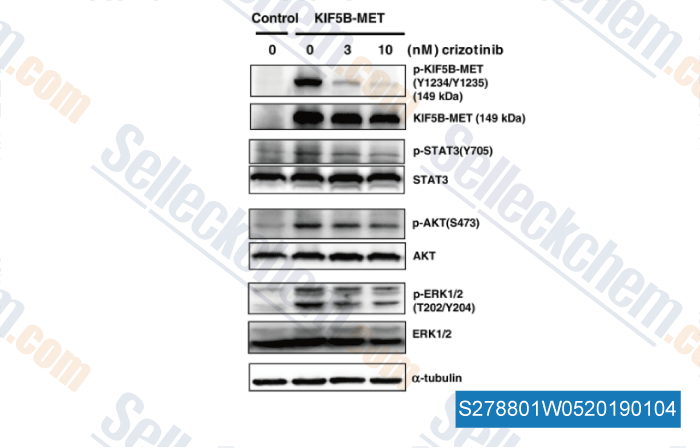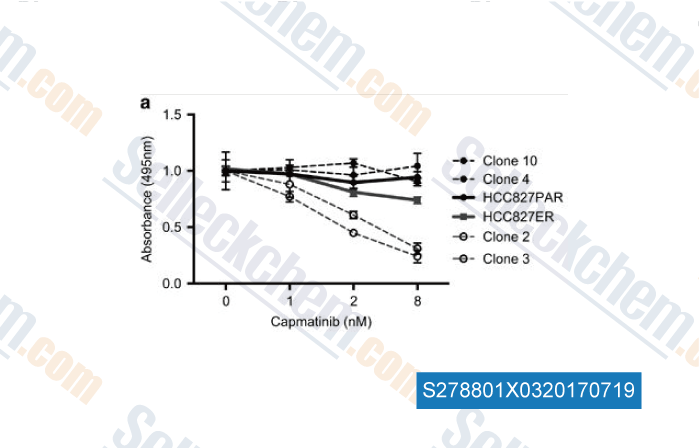|
Toll Free: (877) 796-6397 -- USA and Canada only -- |
Fax: +1-832-582-8590 Orders: +1-832-582-8158 |
Tech Support: +1-832-582-8158 Ext:3 Please provide your Order Number in the email. |
Technical Data
| Formula | C23H17FN6O |
||||||||||
| Molecular Weight | 412.42 | CAS No. | 1029712-80-8 | ||||||||
| Solubility (25°C)* | In vitro | DMSO | 6 mg/mL (14.54 mM) | ||||||||
| Water | Insoluble | ||||||||||
| Ethanol | Insoluble | ||||||||||
| In vivo (Add solvents to the product individually and in order) |
|
||||||||||
|
* <1 mg/ml means slightly soluble or insoluble. * Please note that Selleck tests the solubility of all compounds in-house, and the actual solubility may differ slightly from published values. This is normal and is due to slight batch-to-batch variations. * Room temperature shipping (Stability testing shows this product can be shipped without any cooling measures.) |
|||||||||||
Preparing Stock Solutions
Biological Activity
| Description | Capmatinib is a novel, ATP-competitive inhibitor of c-MET with IC50 of 0.13 nM in a cell-free assay, inactive against RONβ, as well as EGFR and HER-3. Capmatinib (INCB28060) inhibits Wnt/β-catenin and EMT signaling pathways and induces apoptosis in diffuse gastric cancer positive for c-MET amplification. Phase 1. | ||||
|---|---|---|---|---|---|
| Targets |
|
||||
| In vitro | INCB28060 exhibits picomolar enzymatic potency and is highly specific for c-MET with more than 10,000-fold selectivity over a large panel of human kinases. This compound inhibits human c-MET phosphorylation and c-MET-mediated signaling in cancer cells. It inhibits c-MET-dependent cell proliferation and survival, and prevents anchorage-independent cancer cell growth and cell migration. [1] |
||||
| In vivo | INCB28060 shows strong antitumor activity in c-MET-dependent mouse tumor models, even oral treatment of 0.03 mg/kg of this compound causes approximately 50% inhibition of c-MET-phosphorylation. Dose-dependent inhibition of tumor growth is observed in tumor-bearing mice. [1] |
||||
| Features | Inactive against RONβ, another member of the c-MET RTK family, as well as EGFR and HER-3 (members of the EGFR RTK family). |
Protocol (from reference)
| Kinase Assay: |
|
|---|---|
| Cell Assay: |
|
| Animal Study: |
|
References
|
Customer Product Validation

-
, , PLoS One, 2016, 11(3):e0150507.

-
Data from [ , , Clin Cancer Res, 2017, 23(21):6661-6672 ]

-
Data from [ , , Neoplasia, 2018, 20(8):838-847 ]

-
Data from [ , , Oncogenesis, 2017, 6(4):e307 ]
Selleck's Capmatinib (INC280) Has Been Cited by 87 Publications
| Development of a cyst-targeted therapy for polycystic kidney disease using an antagonistic dimeric IgA monoclonal antibody against cMET [ Cell Rep Med, 2025, 6(9):102335] | PubMed: 40914166 |
| PD-L1 regulates c-MET phosphorylation and contributes to MET-dependent resistance to osimertinib in EGFR-mutant NSCLC [ J Biomed Sci, 2025, 32(1):94] | PubMed: 41068729 |
| PI3K-dependent GAB1/Erk phosphorylation renders head and neck squamous cell carcinoma sensitive to PI3Kα inhibitors [ Cell Death Dis, 2025, 16(1):457] | PubMed: 40533463 |
| PTEN loss and ERBB2/ERBB3-mediated AKT reactivation drive resistance to MET inhibition in MET-amplified hepatocellular carcinoma [ Cell Oncol (Dordr), 2025, 10.1007/s13402-025-01097-y] | PubMed: 40991144 |
| Multifactorial stroma-mediated resistance is a major contributor to residual disease under targeted therapies in lung cancers [ Res Sq, 2025, rs.3.rs-6264377] | PubMed: 40313737 |
| Patient-derived rhabdomyosarcoma cells recapitulate the genetic and transcriptomic landscapes of primary tumors [ iScience, 2024, 27(10):110862] | PubMed: 39319271 |
| Synergistic Effects of Neratinib in Combination With Palbociclib or Miransertib in Brain Cancer Cells [ World J Oncol, 2024, 15(3):492-505] | PubMed: 38751701 |
| MUC1-C Is a Common Driver of Acquired Osimertinib Resistance in NSCLC [ J Thorac Oncol, 2023, 10.1016/j.jtho.2023.10.017] | PubMed: 37924972 |
| Suppression of TNBC metastasis by doxazosin, a novel dual inhibitor of c-MET/EGFR [ J Exp Clin Cancer Res, 2023, 10.1186/s13046-023-02866-z] | PubMed: 37924112 |
| FGFR blockade inhibits targeted therapy-tolerant persister in basal FGFR1- and FGF2-high cancers with driver oncogenes [ NPJ Precis Oncol, 2023, 7(1):107] | PubMed: 37880373 |
RETURN POLICY
Selleck Chemical’s Unconditional Return Policy ensures a smooth online shopping experience for our customers. If you are in any way unsatisfied with your purchase, you may return any item(s) within 7 days of receiving it. In the event of product quality issues, either protocol related or product related problems, you may return any item(s) within 365 days from the original purchase date. Please follow the instructions below when returning products.
SHIPPING AND STORAGE
Selleck products are transported at room temperature. If you receive the product at room temperature, please rest assured, the Selleck Quality Inspection Department has conducted experiments to verify that the normal temperature placement of one month will not affect the biological activity of powder products. After collecting, please store the product according to the requirements described in the datasheet. Most Selleck products are stable under the recommended conditions.
NOT FOR HUMAN, VETERINARY DIAGNOSTIC OR THERAPEUTIC USE.
